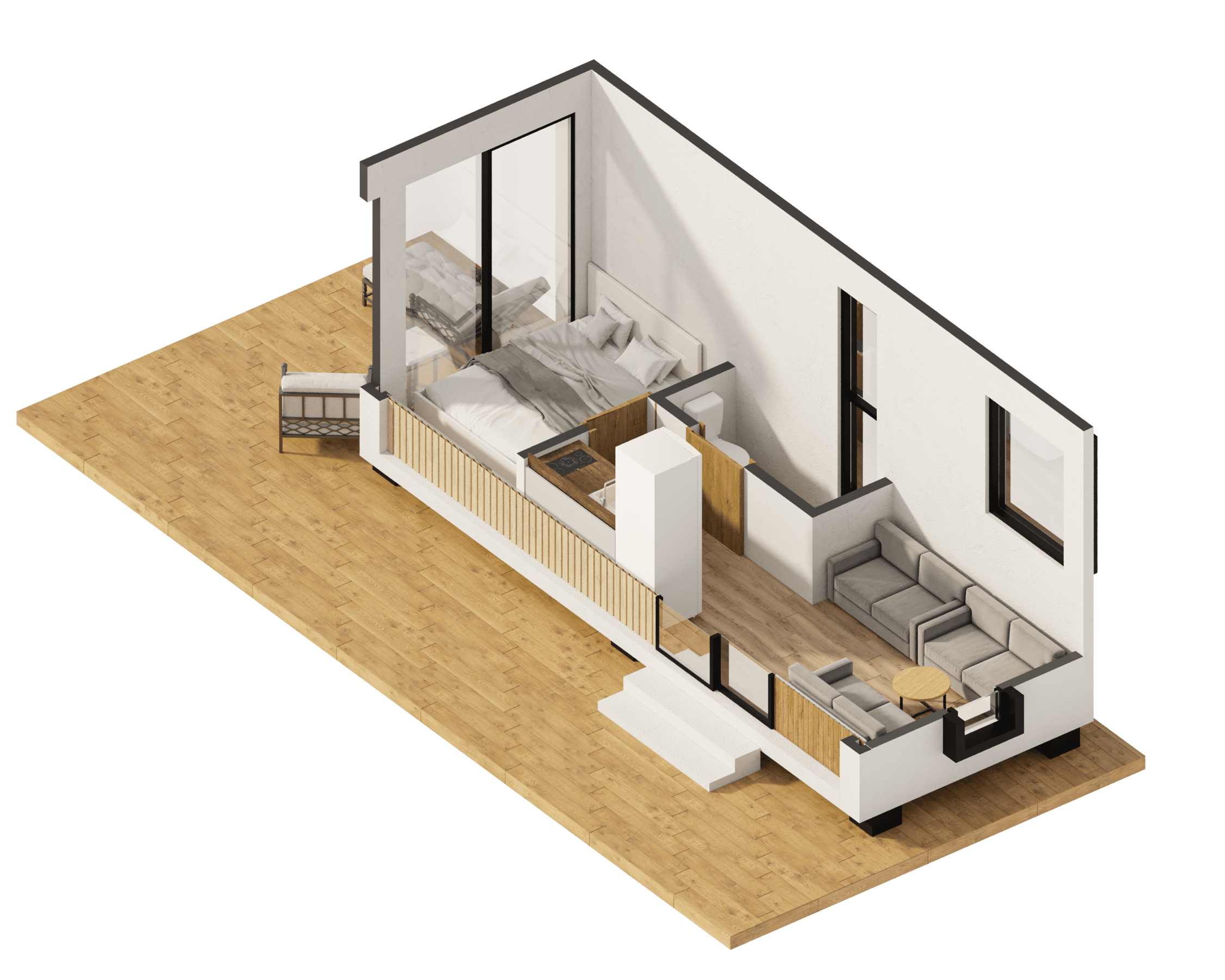AI-Powered 3D Product Renderings: Enhancing eCommerce Experiences
At YouSee Studio, we are currently investigating the potential of AI technologies to enhance our traditional 3D modeling processes. This article provides insights into potential AI applications in 3D rendering, reflecting our commitment to innovation and excellence.
In the ever-evolving digital commerce landscape, businesses constantly seek innovative ways to captivate consumers and stand out in a crowded marketplace. One groundbreaking technology that has emerged as a game-changer is AI-powered 3D product renderings. This cutting-edge approach is revolutionizing how products are presented online, offering an immersive and interactive experience bridging the gap between virtual browsing and physical shopping.
The Evolution of Product Visualization
The journey from static product images to dynamic 3D renderings has been remarkable. Traditional photography, while effective, often needs to convey a product's true essence, especially in terms of scale, texture, and functionality. Enter AI-powered 3D renderings—a technological marvel that's redefining product visualization.
This advanced technology leverages the power of artificial intelligence to create hyper-realistic, three-dimensional representations of products that can be rotated, zoomed and even customized in real-time. The result is an unparalleled level of detail and interactivity previously unimaginable in online shopping.
How AI Enhances 3D Rendering
Integrating AI into 3D rendering processes has led to significant improvements in efficiency and quality. Here's a closer look at how AI is enhancing various aspects of 3D product visualization:
- Automated Modeling: AI algorithms can now accurately generate 3D models from 2D images. This process, which once took skilled 3D artists hours or even days, can now be completed in minutes. For instance, a leading AI-powered 3D rendering platform reported a 90% reduction in modeling time for complex products like furniture and electronics.
- Texture and Material Simulation: AI excels at analyzing and replicating real-world materials. By studying vast databases of textures and materials, AI can generate incredibly lifelike surfaces for 3D models. This capability is precious for industries like fashion and home decor, where the tactile qualities of products are crucial selling points.
- Lighting and Environment Generation: Creating realistic lighting conditions and environments for 3D renderings traditionally required extensive manual work. AI now automates this process, instantly generating photorealistic lighting setups and environments that showcase products in their best light – literally and figuratively.
- Real-Time Customization: One of the most exciting applications of AI in 3D Rendering is the ability to offer real-time product customization. Consumers can now experiment with different colors, materials, and configurations, seeing the results instantly. This level of interactivity enhances the shopping experience and reduces return rates by ensuring customers are fully satisfied with their choices before making a purchase.
The Impact on Consumer Behavior
The introduction of AI-powered 3D renderings has profoundly affected how consumers interact with products online. A study by a significant eCommerce platform in the United States revealed that products featuring 3D visualizations experienced a 40% increase in conversion rates compared to those with traditional 2D images.

Image from Yousee Studio
Moreover, the average time spent on product pages with 3D renderings increased by 60%, indicating higher engagement and interest from potential buyers. This increased engagement translates directly into sales, with some retailers reporting up to a 30% boost in revenue for product lines featuring AI-enhanced 3D visualizations.
In countries, where luxury retail plays a significant economic role, high-end brands have quickly adopted this technology.
Transforming Industries
While the impact of AI-powered 3D renderings is felt across various sectors, specific industries have seen theatrical transformations:
Furniture and Home Decor
The furniture industry has been one of the biggest beneficiaries of this technology. Customers can now visualize how furniture will look in their homes, experiment with different fabrics and finishes, and even use augmented reality to place virtual furniture in their living spaces.
A leading U.S. furniture retailer reported a 35% decrease in returns after implementing AI-powered 3D renderings and AR features, which saved millions in logistics costs and improved customer satisfaction.
Fashion and Apparel
In the fashion world, AI-powered 3D renderings are addressing one of the biggest challenges of online shopping – the inability to try on clothes virtually. Advanced AI algorithms can now create realistic simulations of how garments drape and move on different body types, allowing customers to get a better sense of fit and style before purchasing.
A popular online fashion retailer in the UAE saw a 45% reduction in size-related returns after introducing AI-powered 3D virtual try-on technology, significantly improving their bottom line and customer experience.
Automotive Industry
Car manufacturers and dealerships leverage AI-enhanced 3D renderings to offer virtual showroom experiences. Potential buyers can explore vehicles in detail, customize features, and even take virtual test drives. This approach has been efficient in markets like the U.S., where a prominent automotive brand reported a 20% increase in lead generation through its online 3D configurator.
Technological Advancements Driving the Revolution
Several vital technological advancements underpin the rapid evolution of AI-powered 3D renderings:
Deep Learning and Neural Networks
Applying deep learning algorithms and neural networks has dramatically improved the speed and accuracy of 3D modeling and rendering processes. These AI systems can analyze vast amounts of visual data to generate incredibly detailed and accurate 3D models, often outperforming human artists quickly and consistently.
Real-Time Rendering Engines
Advancements in GPU technology and rendering algorithms have made generating high-quality 3D visuals in real-time possible. This capability is crucial for providing interactive experiences where users can customize products.
Cloud Computing and Edge AI
The power of cloud computing allows for complex rendering tasks to be performed remotely, enabling even mobile devices to showcase high-quality 3D visuals. Additionally, the emergence of edge AI is bringing some of these capabilities directly to user devices, reducing latency and improving the overall user experience.
Integration with Emerging Technologies
AI-powered 3D renderings do not exist in isolation but are being integrated with other cutting-edge technologies to create even more immersive experiences:
Augmented Reality (AR)
Combining AI-generated 3D models with AR technology allows customers to visualize products in their environments. This blend of virtual and real-world experiences is potent in the furniture and home decor industries.
Virtual Reality (VR)
While still in its early stages for eCommerce, integrating AI-powered 3D renderings with VR technology promises to create fully immersive shopping experiences. Imagine walking through a virtual store, examining products in detail, and making purchases – all from the comfort of your home.
Voice Assistants and Natural Language Processing
AI-powered voice assistants are integrated with 3D visualization platforms, allowing users to control and customize 3D renderings using natural language commands. This hands-free interaction adds another layer of convenience and accessibility to the online shopping experience.
Overcoming Challenges and Looking Ahead
Despite the tremendous progress, the widespread adoption of AI-powered 3D renderings in eCommerce still needs some help. These include the initial cost of implementation, the need for standardization across different platforms, and concerns about data privacy and security.
However, the potential benefits far outweigh these challenges. As the technology continues to evolve, we can expect to see even more innovative applications. For instance, AI could generate personalized product recommendations based on a user's interaction with 3D models or create virtual shopping assistants that guide customers through immersive 3D showrooms.

Image from Yousee Studio
In conclusion, AI-powered 3D product renderings are not just enhancing eCommerce experiences – they're reshaping the entire landscape of online retail. By bridging the gap between digital and physical shopping experiences, this technology is setting new standards for customer engagement and satisfaction. As we look to the future, it's clear that the fusion of AI and 3D visualization will continue to push the boundaries of what's possible in eCommerce, creating exciting opportunities for businesses and consumers alike.
For retailers and brands in the United States and the United Arab Emirates, embracing this technology is no longer just an option – it's becoming necessary to stay competitive in an increasingly digital marketplace. As consumers in these tech-forward markets continue to demand more engaging and informative online shopping experiences, AI-powered 3D renderings will undoubtedly play a crucial role in shaping the future of eCommerce.
Contact us at YouSee Studio for captivating 3D renderings and immersive virtual experiences.
Ray Lisbon is a content writer and the author of this article.






